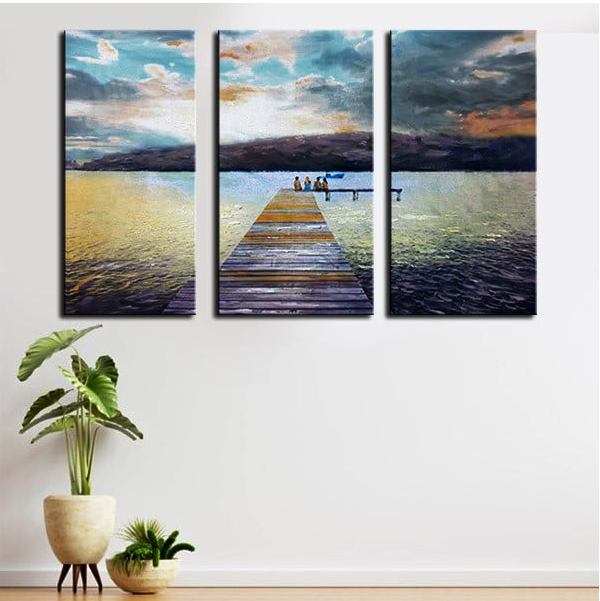The Role of Color and Composition in Photo to Portrait Paintings
However, to create a truly remarkable piece, artists must understand the role of color and composition in these Photos to Portrait Paintings.
Let's start with the color psychology and techniques!!
Understanding Colors in Portrait Paintings
Theory: Color plays a vital role in portraying the subject's emotions and enhancing the overall impact of the artwork. By leveraging color theory, artists can create harmony or contrast within their portraits. Additionally, colors have the power to evoke specific emotions in the viewer, making them an essential tool for visual storytelling.
Psychology: To effectively use color, artists must understand color psychology. Each color carries its symbolic meaning and can evoke various emotions. For example, warm tones such as red and orange are often associated with passion and energy, while cool tones, including blue and green, can evoke a sense of calmness or melancholy. Artists can amplify the desired emotional response by strategically incorporating these colors into the portrait.
Techniques: Techniques such as color blocking, glazing, and layering allow artists to manipulate colors and achieve the desired effects. Experimenting with different hues, shades, and tones helps create depth and dimension, making the portrait visually captivating.
Composition in Portrait Paintings
Composition refers to the sequence of elements within the artwork and guides the viewer's gaze. A well-composed portrait draws the viewer's attention to the subject and creates a visually pleasing and balanced composition.
The Rule of Thirds and Balance
The rule of thirds is a famous composition technique where the canvas is divided into a 3x3 grid. Placing the subject along these gridlines or at the intersection points creates a sense of balance and harmony. This technique helps avoid placing the subject in the center, which can result in a static and uninteresting composition.
Leading Lines and Visual Flow
Leading lines are another powerful composition tool. Artists can use natural lines, such as the curve of a shoulder or the tilt of the head, to guide the viewer's eye toward the subject. These lines add depth and create a sense of movement within the portrait.
Framing and Focal Points
Framing and focal points also contribute to the composition. Artists can use elements within the painting to create a frame around the subject, drawing attention to them. Additionally, establishing a clear focal point helps anchor the viewer's gaze and emphasizes specific details.
Creating Realistic Portraits with Color and Composition
When transforming a photo into a portrait, it is essential to analyze the reference photo thoroughly. Observing the colors in the image and understanding how they translate into paint is crucial. You can identify the dominant hues and use them as a foundation while adding their artistic interpretation. Striking a balance between realism and personal style allows the artist to create a unique and captivating portrait.
Incorporating composition techniques from the outline stage ensures the portrait has a strong visual impact. Artists can make conscious decisions about the placement of the subject, the use of leading lines, and the overall composition to create harmonious and engaging artwork.
The Artistic Interpretation of Portraits
Adding personal style and creativity
While Photos to Portrait Paintings aim to capture the subject's likeness, artists also have the opportunity to infuse their personal style and creativity.
Experimenting with color schemes and compositions
Artists can experiment with unconventional color schemes or exaggerated compositions to create visually striking portraits that stand out.
Balancing realism and artistic expression
Artistic interpretation allows artists to add depth and narrative to the artwork. By going beyond replicating the photo, artists can convey emotions, tell stories, or highlight certain aspects of the subject's personality. This creative freedom enables artists to produce portraits that resonate with both the subject and the viewer.
The Impact of Color and Composition on Viewer's Perception
Evoking emotions and moods
The strategic use of color and composition can significantly influence how viewers perceive and interpret a portrait. By selecting specific colors and employing composition techniques, artists can evoke certain emotions, direct the viewer's gaze, and create a sense of depth and dimension within the artwork.
Directing the viewer's gaze
For example, warm colors can elicit feelings of happiness or passion, while cool colors can evoke a sense of calmness or melancholy. The placement of leading lines can guide the viewer's eye toward the subject or create a dynamic flow within the portrait.
Creating a sense of depth and dimension
Additionally, the careful use of framing and focal points can add depth and draw attention to specific areas of interest.
This is it! Color and composition are integral elements in creating Photos to Portrait Paintings. By understanding color theory with the help of Snappy Canvas, artists can evoke emotions and create visually harmonious artworks. Composition techniques guide the viewer's gaze and contribute to a balanced and engaging composition. Combining these elements allows artists to transform a photo into a captivating and unique portrait that resonates with both the subject and the viewer. Find your perspective!!
.jpg)
.jpg)


Comments
Post a Comment